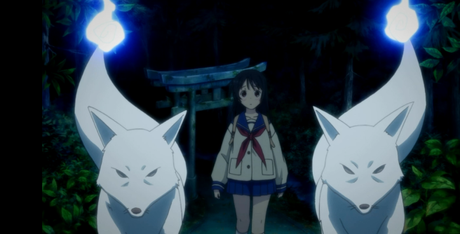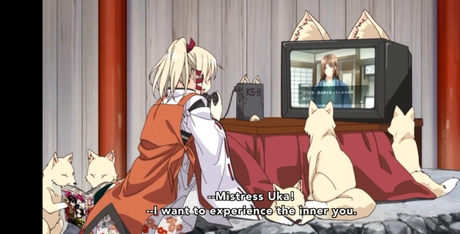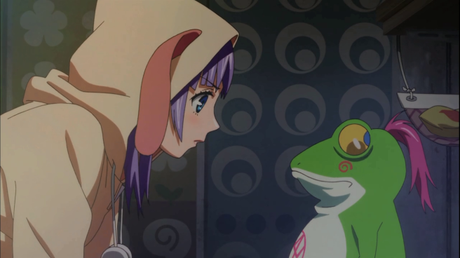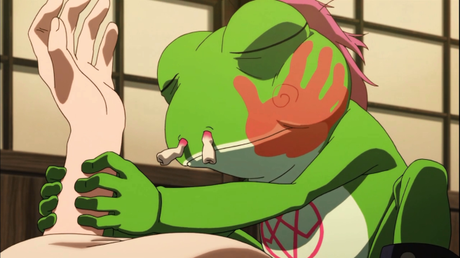Inari, Konkon, Koi Iroha

Maggie: There have certainly been an abundance of Shinto-inspired, and particularly Inari-focused, anime these past few seasons. While these types of anime provide a deserved amount of cultural insight, it’s becoming a double-edged sword: the market is quickly becoming saturated, competition between series is fiercer, and if you want to make it in this genre, the few first episodes are going to be a do-or-die moment. Gingitsune just ended this past fall season and was a successfully light-hearted, warm-and-fuzzy, and emotionally touching series, so Inari, Konkon, Koi Iroha will have to shake the game up in order to garner the respect and fanbase that so many similar series have achieved.
Inari, Konkon, Koi Iroha made the wise decision not to follow explicitly in any predecessor’s footsteps. This series is a romantic comedy with a few subtle, ominous components thrown in. The main character, Inari, is a middle-school student, so the audience is a little younger here, but the comedic elements of the show will hopefully attract some older viewers. The basic premise of the show is centered around Inari’s current unrequited love, Tanbabashi, the school’s basketball star. All the usual ingredients of a shoujo love comedy are there–the popular and pretty love rival, the two best friends (one characteristically rough and stubborn, the other a little weird), the over-protective older brother, and a few supernatural elements. Inari, as we find out in this episode, has a natural attunement to the spiritual world and soon befriends the local Inari shrine god, Uka no Mitami no Kami (Uka-sama, for short), after rescuing one of her familiars. Uka-sama grants her one wish, and, disappointingly, Inari wishes to become the love interest of her love interest, Sumizome. Within a couple hours, Inari already regrets her decision, and visits Uka-sama to have her wish undone. Unfortunately, Uka-sama isn’t allowed to show Inari favoritism and cannot ungrant her wish–but wait! Instead, Uka-sama decides to give Inari part of her divine essence (and, honestly, if that isn’t favoritism, I don’t know what is) and the ability to transform into any human.
Unfortunately, this first episode is largely forgettable. Inari is your typical heroine–clumsy, well-meaning but always accidentally causing embarrassing situations for herself and others (especially for her crush, Tanbabashi), and emotionally and intellectually immature (eg. lots of crying and poor decisions). And because she takes up so much screen time being the main character, most of the episode is uninteresting and spent dealing with the consequences of her juvenile decisions. It’s hard to really feel sympathetic towards Inari’s romantic plight–after all, she’s just a middle school student, and so much of pre-teen life matters so little in the long run. The only saving graces this show has to offer so far are the foreshadowed dramatic encounters and Uka-sama and her entourage of fox spirits.

Refreshingly, the Inari god in Inari, Konkon, Koi Iroha is female. She has a sense of humor, too, and offers the audience the show’s only laughable attempts at comedy–the scene where she is caught playing Otome games is pure fun, and only funnier when we find out that her spirit familiars transformed into the game console so that she could indulge in her guilty pleasure. Out of all of the relationships introduced in this first episode, the one between Inari and Uka-sama is the one I look forward to most of all. If the show executes it correctly, it could be a dynamic and tantalizingly mystic and dramatic relationship–because giving a human part of your divine essence without permission from Amaterasu-sama isn’t something to be taken lightly and could have some serious implications for Inari and Uka-sama later on. Additionally, the show is already beginning to foreshadow some darker elements. Inari’s powers will inevitably land her in some complicated and embarrassing situations. More interestingly, though, her brother shoots Uka-sama a daring and formidable glare near the end of the episode. How is he able to see her, and what sort of challenge was given by that glance?
While Inari, Konkon, Koi Iroha could redeem itself in later episodes, this debut so far appears to be your typical pre-teen shoujo romantic comedy with a predictable outcome. If the show continues to rely on those elements rather than utilizing the darker aspects of the story, Inari, Konkon, Koi Iroha will just be another dud of a show. However, if it takes the more dramatic road, we might have something halfway watchable on our hands.
Wizard Barristers
Naru: Wizard Barristers turned out better than I expected. For a first episode, of course.

To most, Cecil Sudo might look like you’re your typical, giddy Canadian anime girl, but that first impression is quickly shot down once we learn that she is the youngest wizard defense attorney (called “Benmashi”) in history. And along with her talking familiar of a frog and colleagues who have no taste in fashion, she makes it her goal to do everything she can to save wizards from being wrongly accused.
As I’ve mentioned before, I didn’t expect Wizard Barristers to be this good – or at least I didn’t expect myself to really enjoy it, since I don’t watch anime with wizards and usually avoid them like the plague. But because it’s 2014 and I want to try out new things (and this also includes genres of anime I haven’t seen yet), Wizard Barristers seemed like a decent anime to try out – you don’t see anime about attorneys being made every day. Plus, the art looked pretty neat and I was curious to see how it would look like in movement.

Regarding the heroine’s design, I know that I’m not going to have an easy time getting used to her face. Her large, round eyes fill up most of her round face in a shoujo-esque way – and you would barely notice her lips if she didn’t talk- which are traits I still have a hard time adapting to most of the time, especially when the characters in the concerned work don’t share these same traits.

Regarding the story and where it wants to lead us, we’re not sure what the creators have in store for us. Will the story focus on the Cecil handling cases/helping her colleagues? On the discrimination against wizards? Or will it focus more on Cecil’s background? Since we weren’t given a clear direction as to what we’re going to see next, I’m a bit frustrated of being left in the dark (even if it is for a short period of time), yet also looking very forward to see what happens.
Also, Wakamoto playing a frog makes things so much better.

